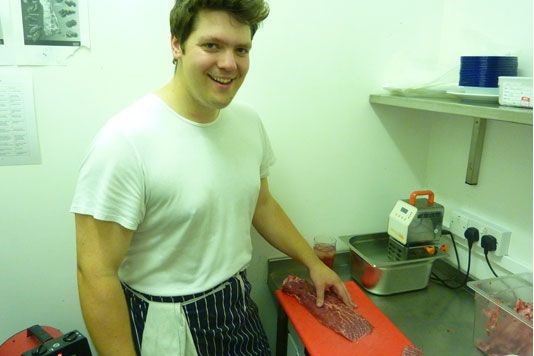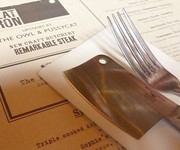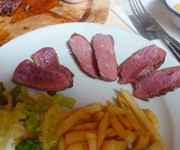Introducing the flat iron steak

It's the second tenderest cut on the cow after fillet, and costs a lot less, yet is seldom seen in the shops. Andrew Webb ruminates on the flat iron steak.
One of the first things you realise about beef is that there’s more than one way to cut up a cow. The art of butchery differs from country to country, even region to region in some cases. Sometimes even the same cuts have different names depending on where you are, so although the flat iron is the American name for this cut, it also goes by the name blade steak, petite steak, lifter steak, book steak, oyster blade (AUS) and butler’s steak (UK). (See this blog for more details and here for more history)
On the menu
 Chef Charlie Carroll (picture top) has built his new business venture on this particular cut of beef. Flat Iron is a restaurant in residence above the Owl and the Pussy Cat pub in Shoreditch, East London for the next six weeks. “This has been a perfect opportunity, in that it works well for both the pub and for me. I don’t have to go through the effort of getting permanent premises, and the outlay and hassle that go with that,” he tells me.
Chef Charlie Carroll (picture top) has built his new business venture on this particular cut of beef. Flat Iron is a restaurant in residence above the Owl and the Pussy Cat pub in Shoreditch, East London for the next six weeks. “This has been a perfect opportunity, in that it works well for both the pub and for me. I don’t have to go through the effort of getting permanent premises, and the outlay and hassle that go with that,” he tells me.
So why the flat iron?
“If you want to have really good steak, the likes of Hawksmoor and Goodman’s do an amazing job and I love going there. But they’re expensive,” he says. So he asked himself the question, ‘how do you get an amazing steak at reasonable prices?’ “Flicking through different cuts that offer that value, we looked at onglet, bavette, thick and thin skirt. But the feather blade (from which the flat iron comes) is still reasonably priced.” The meat has to be well looked after, aged and finished correctly, and Charlie is getting his from rare British beef breeds such as the Red Ruby and White Park.
Meet the meat
The flat iron comes from the shoulder, out of the chuck, taken off the feather blade. Most flat iron in the UK goes into burgers or stewing steak. “It’s got gristle all around it, and other side muscles, and a sheet of gristle running through the middle, all of which have to be taken off which is time consuming. And you’ve got to be fairly skilled to know what you’re doing to leave a reasonable amount of steak. But if you do all that you’re left with the second most tender muscle on the cow after the fillet, but it’s got a far higher natural marbling level than fillet and juiciness,” says Charlie.
The taste test
 I tried three flat irons, two English (one done medium rare, and one rare) and one USDA Prime which was on as a special. American meat is often fed and finished on grain rather than grass. The American steak was juicy and easy to eat, but for me lacked the depth of flavour and complexity of the English version. (This only served to confirm my view that Americans don’t like to have to chew their food too much!)
I tried three flat irons, two English (one done medium rare, and one rare) and one USDA Prime which was on as a special. American meat is often fed and finished on grain rather than grass. The American steak was juicy and easy to eat, but for me lacked the depth of flavour and complexity of the English version. (This only served to confirm my view that Americans don’t like to have to chew their food too much!)
Ask your butcher for it…
…And he might moan a little before trimming a couple up for you. But in return you get a great tasting steak at a really good price. It’s not a huge cut, so is perfect for slapping on a fierce burning barbecue and cooking quickly. If you’re anywhere near a Q Guild Butcher, I’ve found members of this organisation tend to know their stuff and source excellent meat.
Have you ever tried the flat iron? Or do you prefer another cut of steak? Let us know in the comments box below.
More meaty things
Comments
Be the first to comment
Do you want to comment on this article? You need to be signed in for this feature